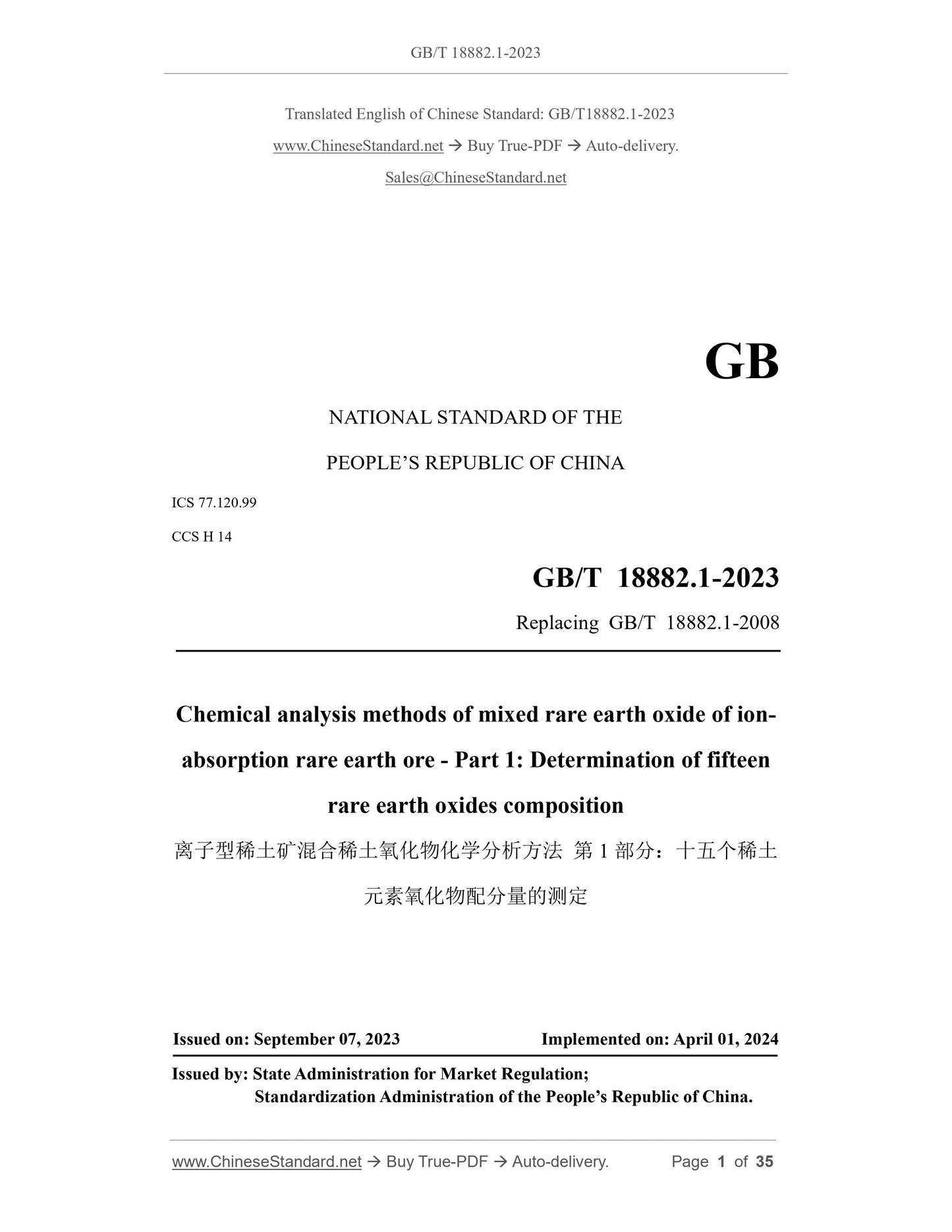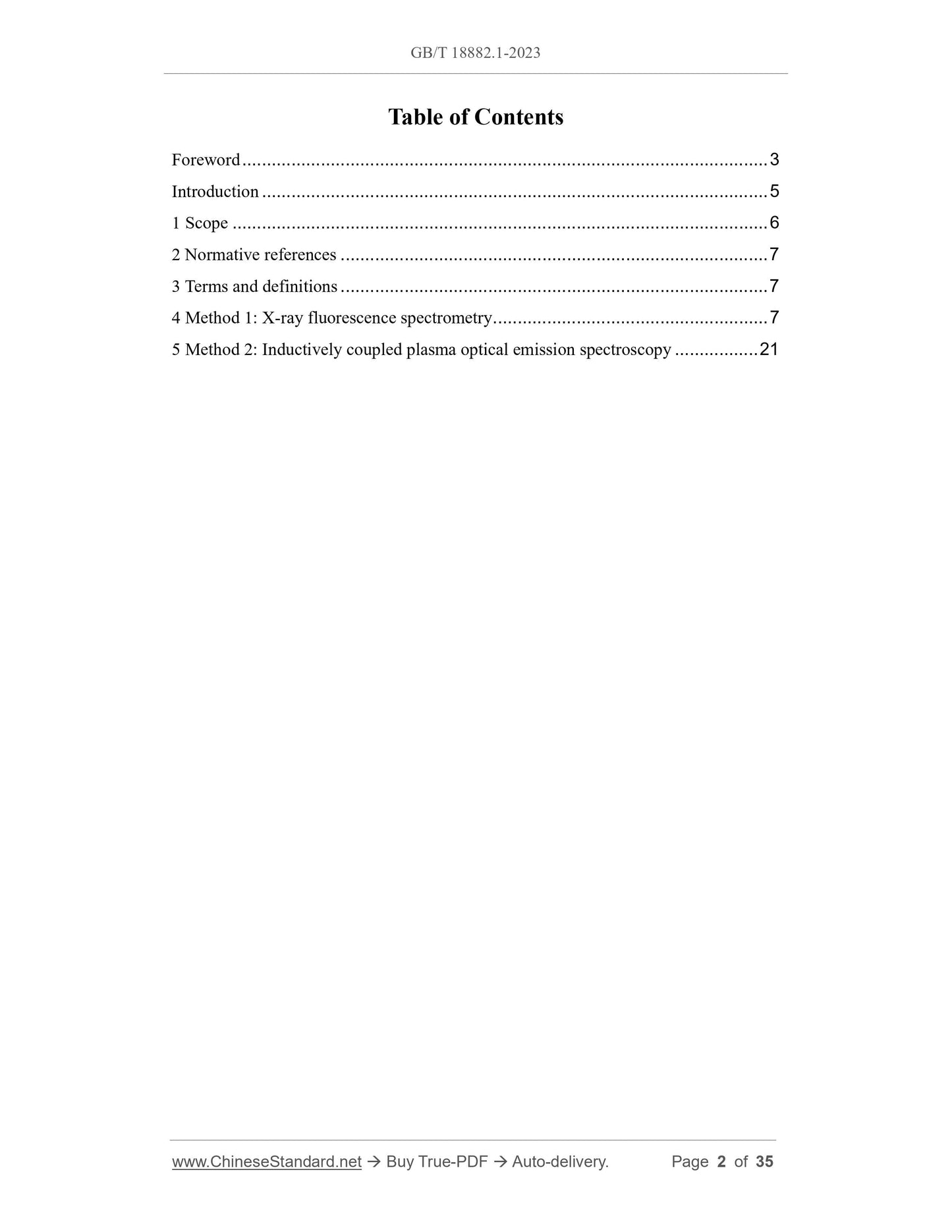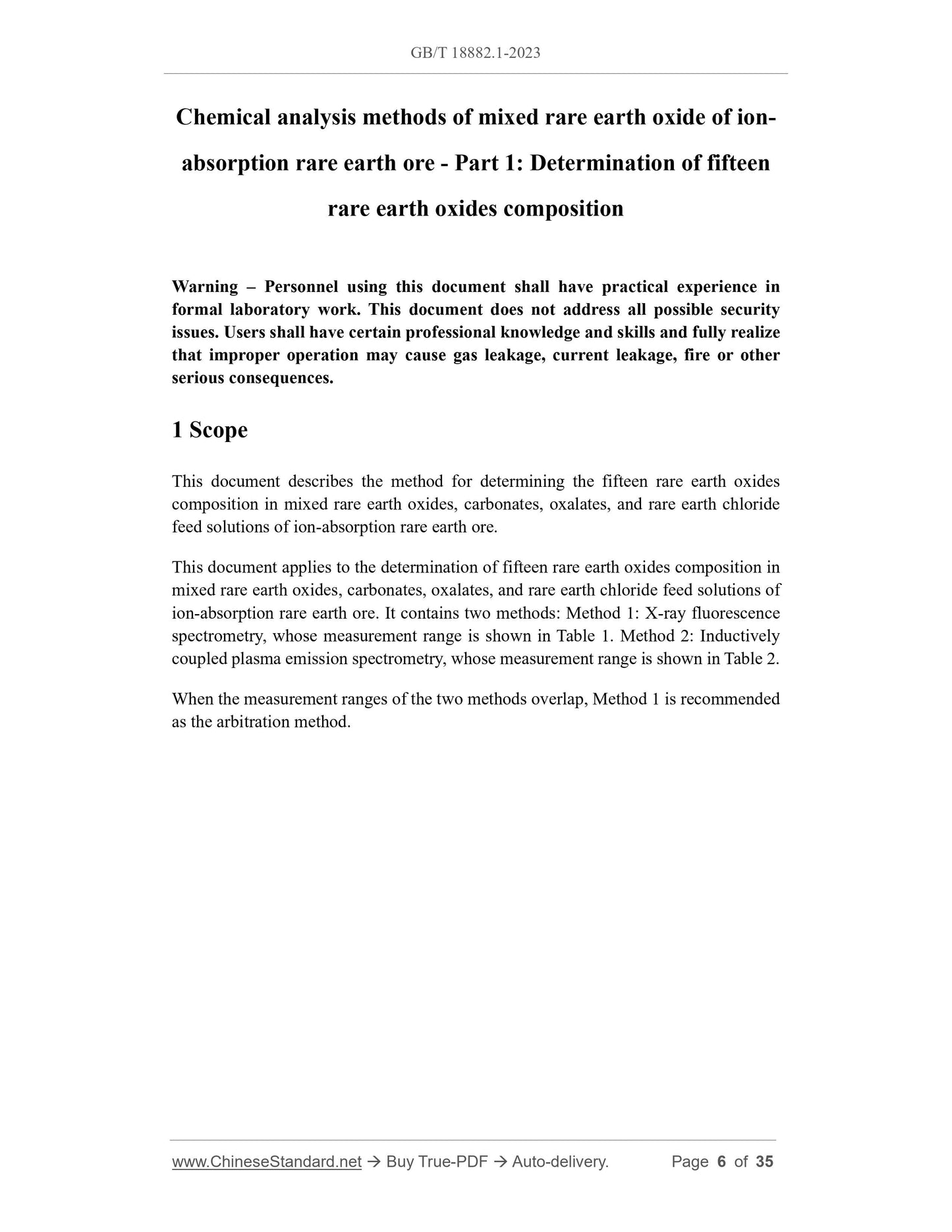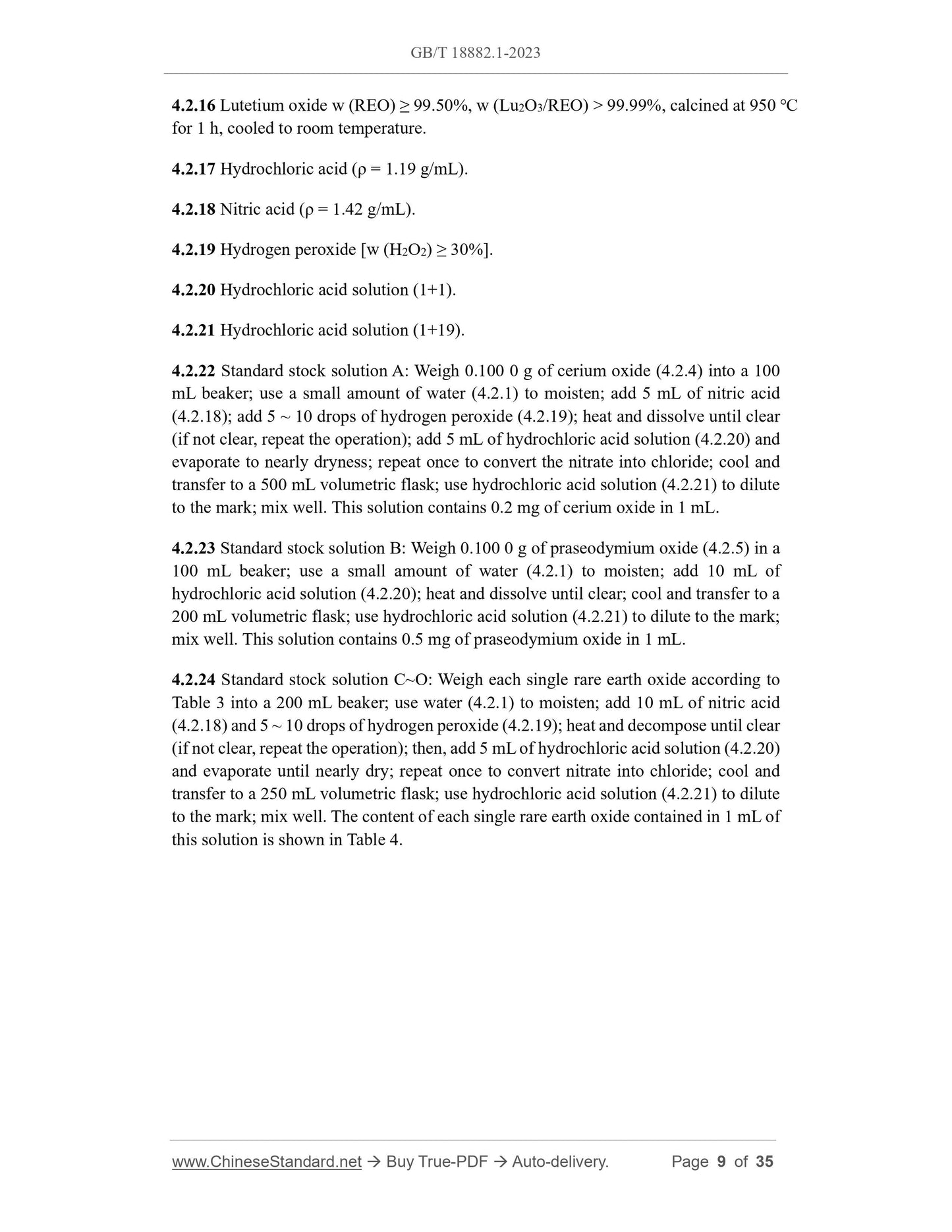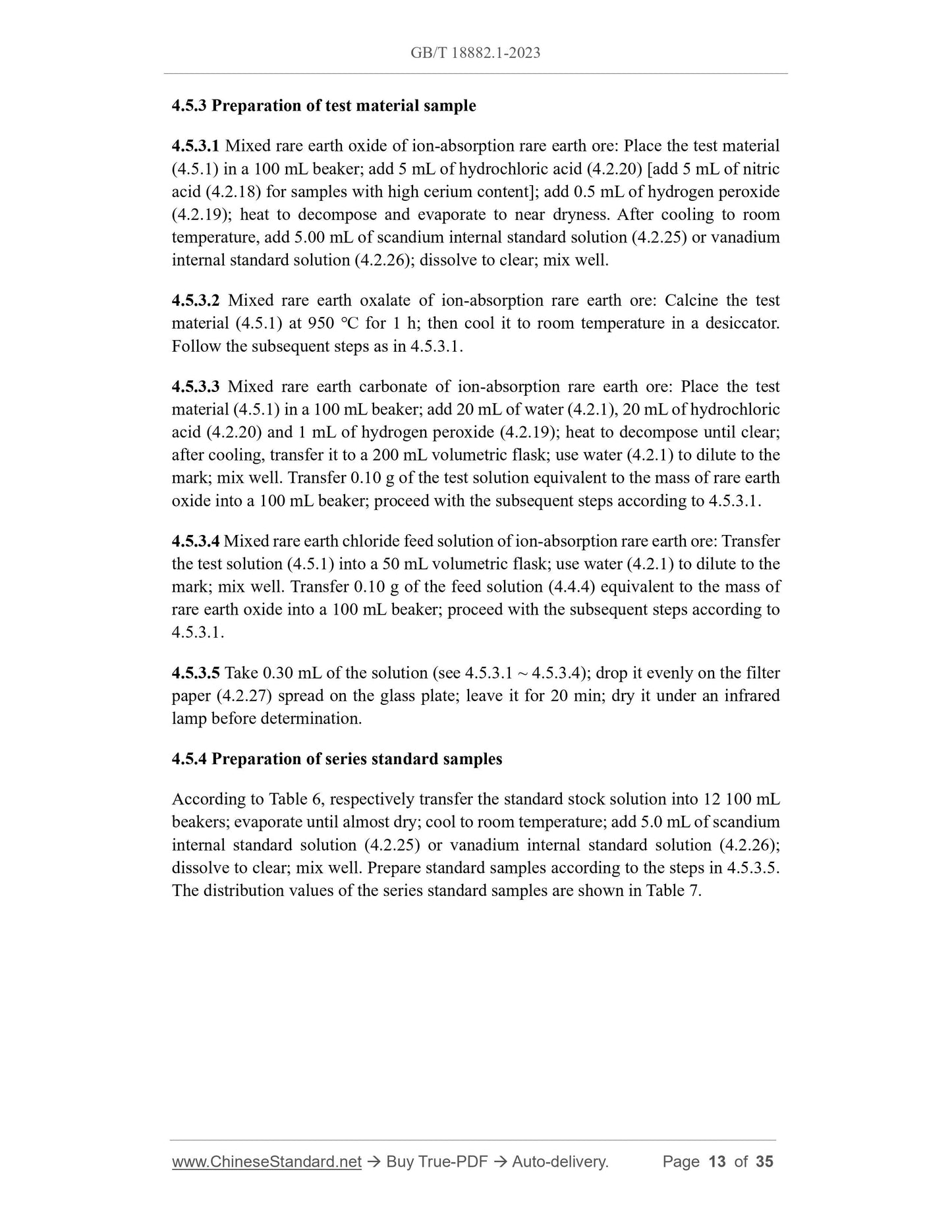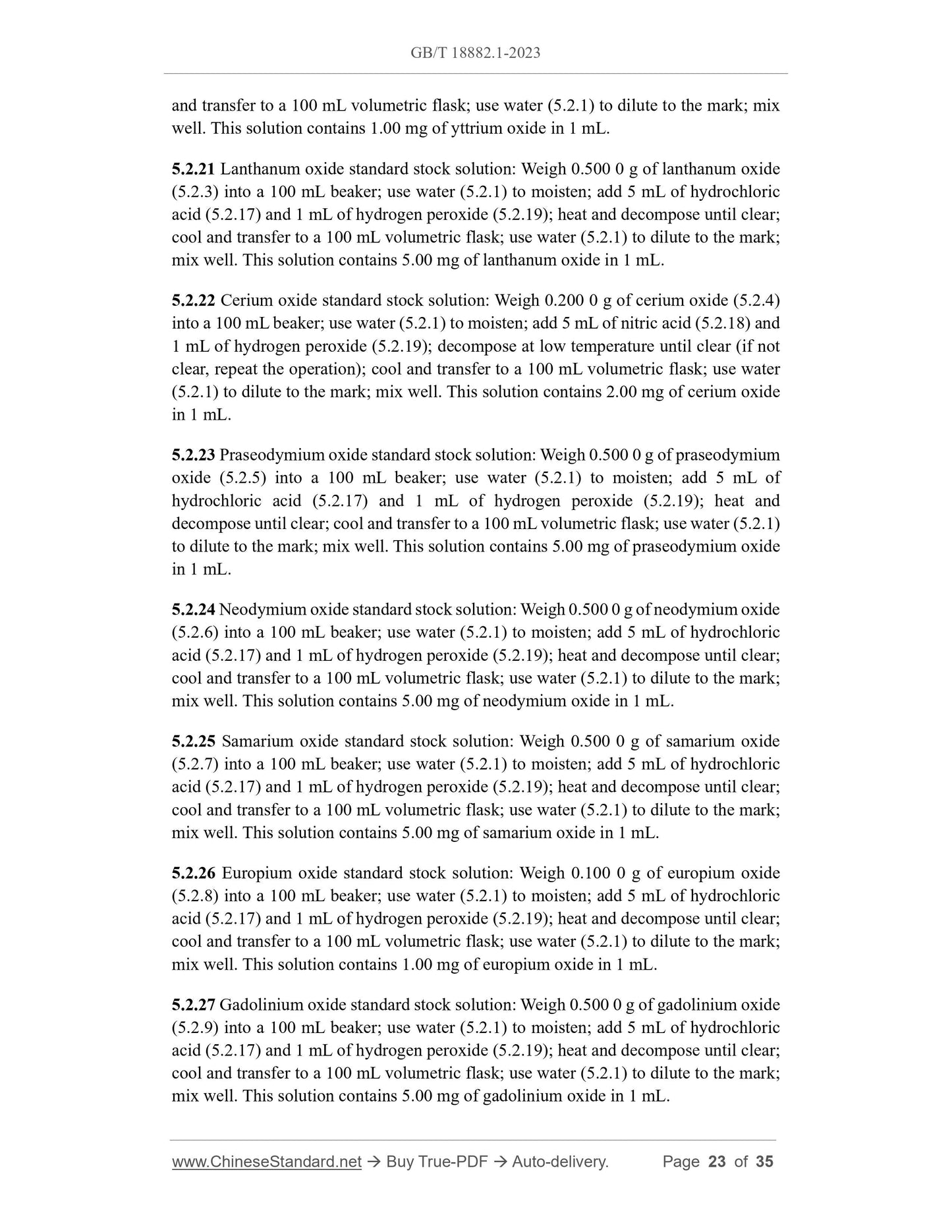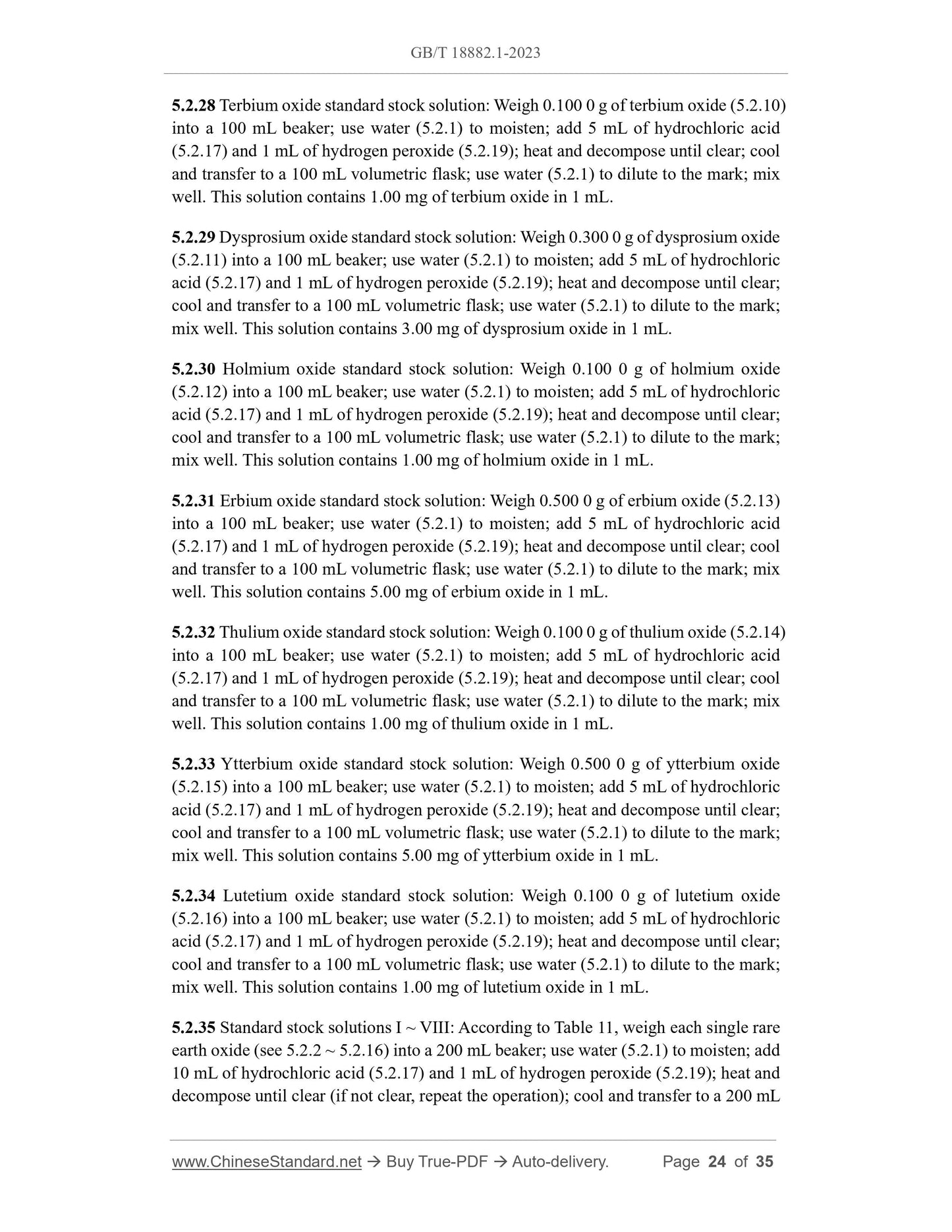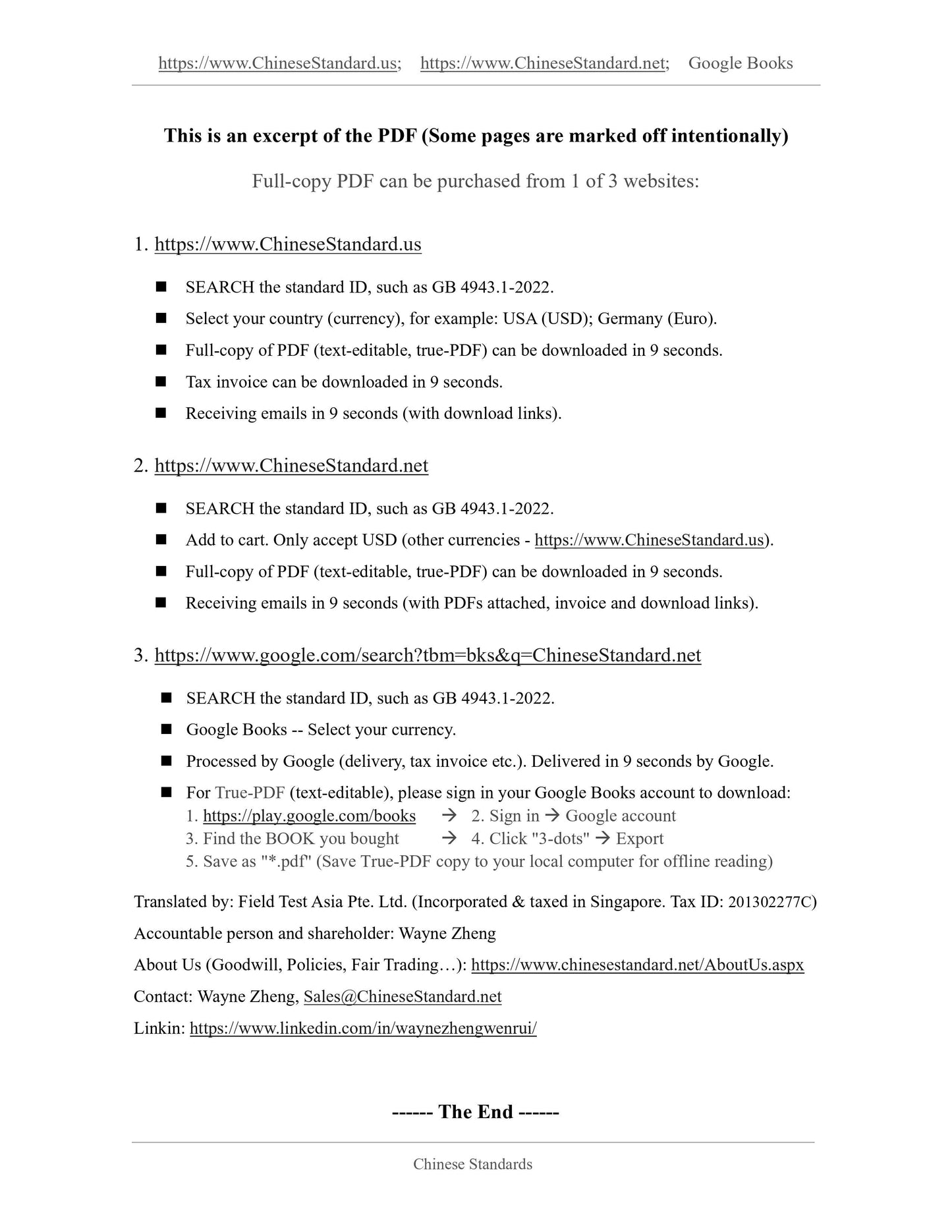1
/
of
8
www.ChineseStandard.us -- Field Test Asia Pte. Ltd.
GB/T 18882.1-2023 English PDF (GB/T18882.1-2023)
GB/T 18882.1-2023 English PDF (GB/T18882.1-2023)
Regular price
$380.00
Regular price
Sale price
$380.00
Unit price
/
per
Shipping calculated at checkout.
Couldn't load pickup availability
GB/T 18882.1-2023: Chemical analysis methods of mixed rare earth oxide of ion-absorption rare earth ore - Part 1: Determination of fifteen rare earth oxides composition
Delivery: 9 seconds. Download (and Email) true-PDF + Invoice.Get Quotation: Click GB/T 18882.1-2023 (Self-service in 1-minute)
Newer / historical versions: GB/T 18882.1-2023
Preview True-PDF
Scope
This document describes the method for determining the fifteen rare earth oxidescomposition in mixed rare earth oxides, carbonates, oxalates, and rare earth chloride
feed solutions of ion-absorption rare earth ore.
This document applies to the determination of fifteen rare earth oxides composition in
mixed rare earth oxides, carbonates, oxalates, and rare earth chloride feed solutions of
ion-absorption rare earth ore. It contains two methods. Method 1.X-ray fluorescence
spectrometry, whose measurement range is shown in Table 1.Method 2.Inductively
coupled plasma emission spectrometry, whose measurement range is shown in Table 2.
When the measurement ranges of the two methods overlap, Method 1 is recommended
as the arbitration method.
4.2.16 Lutetium oxide w (REO) ≥ 99.50%, w (Lu2O3/REO) > 99.99%, calcined at 950 ℃
for 1 h, cooled to room temperature.
4.2.17 Hydrochloric acid (ρ = 1.19 g/mL).
4.2.18 Nitric acid (ρ = 1.42 g/mL).
4.2.19 Hydrogen peroxide [w (H2O2) ≥ 30%].
4.2.20 Hydrochloric acid solution (1+1).
4.2.21 Hydrochloric acid solution (1+19).
4.2.23 Standard stock solution B. Weigh 0.100 0 g of praseodymium oxide (4.2.5) in a
100 mL beaker; use a small amount of water (4.2.1) to moisten; add 10 mL of
hydrochloric acid solution (4.2.20); heat and dissolve until clear; cool and transfer to a
200 mL volumetric flask; use hydrochloric acid solution (4.2.21) to dilute to the mark;
mix well. This solution contains 0.5 mg of praseodymium oxide in 1 mL.
4.2.24 Standard stock solution C~O. Weigh each single rare earth oxide according to
4.5.3 Preparation of test material sample
4.5.3.1 Mixed rare earth oxide of ion-absorption rare earth ore. Place the test material
(4.5.1) in a 100 mL beaker; add 5 mL of hydrochloric acid (4.2.20) [add 5 mL of nitric
acid (4.2.18) for samples with high cerium content]; add 0.5 mL of hydrogen peroxide
(4.2.19); heat to decompose and evaporate to near dryness. After cooling to room
temperature, add 5.00 mL of scandium internal standard solution (4.2.25) or vanadium
internal standard solution (4.2.26); dissolve to clear; mix well.
4.5.3.2 Mixed rare earth oxalate of ion-absorption rare earth ore. Calcine the test
material (4.5.1) at 950 ℃ for 1 h; then cool it to room temperature in a desiccator.
Follow the subsequent steps as in 4.5.3.1.
4.5.3.1.
4.5.3.5 Take 0.30 mL of the solution (see 4.5.3.1 ~ 4.5.3.4); drop it evenly on the filter
paper (4.2.27) spread on the glass plate; leave it for 20 min; dry it under an infrared
lamp before determination.
4.5.4 Preparation of series standard samples
According to Table 6, respectively transfer the standard stock solution into 12 100 mL
beakers; evaporate until almost dry; cool to room temperature; add 5.0 mL of scandium
internal standard solution (4.2.25) or vanadium internal standard solution (4.2.26);
dissolve to clear; mix well. Prepare standard samples according to the steps in 4.5.3.5.
The distribution values of the series standard samples are shown in Table 7.
and transfer to a 100 mL volumetric flask; use water (5.2.1) to dilute to the mark; mix
well. This solution contains 1.00 mg of yttrium oxide in 1 mL.
5.2.21 Lanthanum oxide standard stock solution. Weigh 0.500 0 g of lanthanum oxide
(5.2.3) into a 100 mL beaker; use water (5.2.1) to moisten; add 5 mL of hydrochloric
acid (5.2.17) and 1 mL of hydrogen peroxide (5.2.19); heat and decompose until clear;
cool and transfer to a 100 mL volumetric flask; use water (5.2.1) to dilute to the mark;
mix well.
5.2.23 Praseodymium oxide standard stock solution. Weigh 0.500 0 g of praseodymium
oxide (5.2.5) into a 100 mL beaker; use water (5.2.1) to moisten; add 5 mL of
hydrochloric acid (5.2.17) and 1 mL of hydrogen peroxide (5.2.19); heat and
decompose until clear; cool and transfer to a 100 mL volumetric flask; use water (5.2.1)
to dilute to the mark; mix well. This solution contains 5.00 mg of praseodymium oxide
in 1 mL.
5.2.27 Gadolinium oxide standard stock solution. Weigh 0.500 0 g of gadolinium oxide
(5.2.9) into a 100 mL beaker; use water (5.2.1) to moisten; add 5 mL of hydrochloric
acid (5.2.17) and 1 mL of hydrogen peroxide (5.2.19); heat and decompose until clear;
cool and transfer to a 100 mL volumetric flask; use water (5.2.1) to dilute to the mark;
mix well. This solution contains 5.00 mg of gadolinium oxide in 1 mL.
5.2.28 Terbium oxide standard stock solution. Weigh 0.100 0 g of terbium oxide (5.2.10)
into a 100 mL beaker; use water (5.2.1) to moisten; add 5 mL of hydrochloric acid
(5.2.17) and 1 mL of hydrogen peroxide (5.2.19); heat and decompose until clear; cool
and transfer to a 100 mL volumetric flask; use water (5.2.1) to dilute to the mark; mix
well. This solution contains 1.00 mg of terbium oxide in 1 mL.
5.2.31 Erbium oxide standard stock solution. Weigh 0.500 0 g of erbium oxide (5.2.13)
into a 100 mL beaker; use water (5.2.1) to moisten; add 5 mL of hydrochloric acid
(5.2.17) and 1 mL of hydrogen peroxide (5.2.19); heat and decompose until clear; cool
and transfer to a 100 mL volumetric flask; use water (5.2.1) to dilute to the mark; mix
well. This solution contains 5.00 mg of erbium oxide in 1 mL.
5.2.32 Thulium oxide standard stock solution. Weigh 0.100 0 g of thulium oxide (5.2.14)
into a 100 mL beaker; use water (5.2.1) to moisten; add 5 mL of hydrochloric acid
(5.2.17) and 1 mL of hydrogen peroxide (5.2.19); heat and decompose until clear; cool
and transfer to a 100 mL volumetric flask; use water (5.2.1) to dilute to the mark; mix
well. This solution contains 1.00 mg of thulium oxide in 1 mL.
5.2.33 Ytterbium oxide standard stock solution. Weigh 0.500 0 g of ytterbium oxide
(5.2.15) into a 100 mL beaker; use water (5.2.1) to moisten; add 5 mL of hydrochloric
acid (5.2.17) and 1 mL of hydrogen peroxide (5.2.19); heat and decompose until clear;
cool and transfer to a 100 mL volumetric flask; use water (5.2.1) to dilute to the mark;
mix well. This solution contains 5.00 mg of ytterbium oxide in 1 mL.
5.2.34 Lutetium oxide standard stock solution. Weigh 0.100 0 g of lutetium oxide
(5.2.16) into a 100 mL beaker; use water (5.2.1) to moisten; add 5 mL of hydrochloric
acid (5.2.17) and 1 mL of hydrogen peroxide (5.2.19);
5.2.35 Standard stock solutions I ~ VIII. According to Table 11, weigh each single rare
earth oxide (see 5.2.2 ~ 5.2.16) into a 200 mL beaker; use water (5.2.1) to moisten; add
10 mL of hydrochloric acid (5.2.17) and 1 mL of hydrogen peroxide (5.2.19);
Basic Data
| Standard ID | GB/T 18882.1-2023 (GB/T18882.1-2023) |
| Description (Translated English) | Chemical analysis methods of mixed rare earth oxide of ion-absorption rare earth ore - Part 1: Determination of fifteen rare earth oxides composition |
| Sector / Industry | National Standard (Recommended) |
| Classification of Chinese Standard | H14 |
| Classification of International Standard | 77.120.99 |
| Word Count Estimation | 27,295 |
| Date of Issue | 2023-09-07 |
| Date of Implementation | 2024-04-01 |
| Older Standard (superseded by this standard) | GB/T 18882.1-2008 |
| Issuing agency(ies) | State Administration for Market Regulation, China National Standardization Administration |
Share
